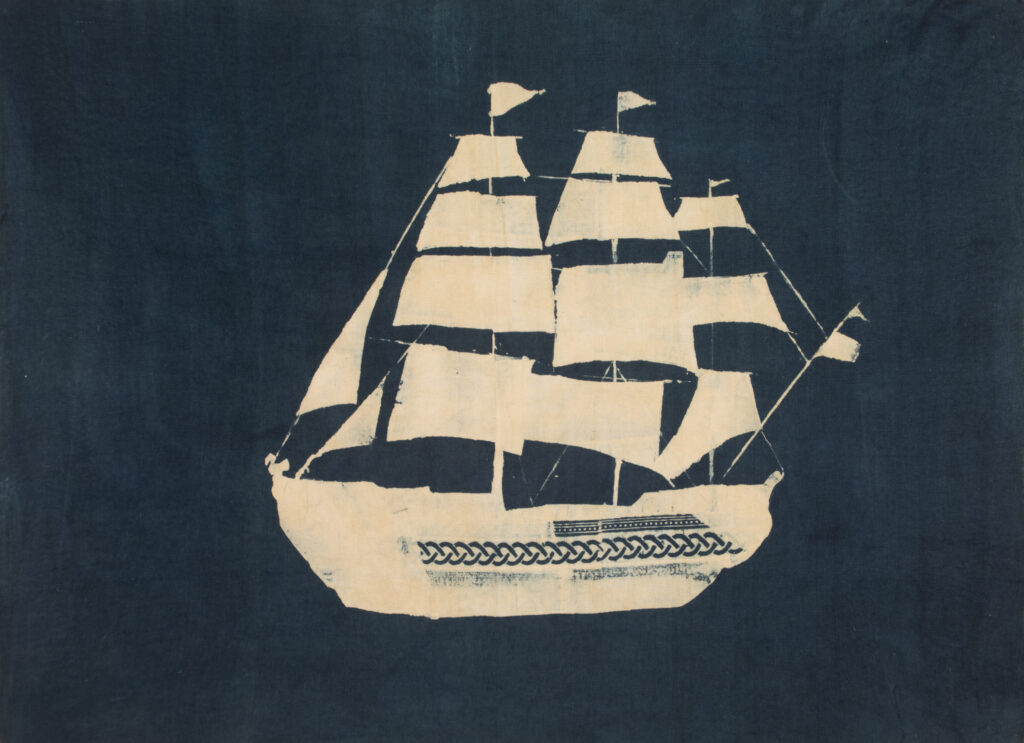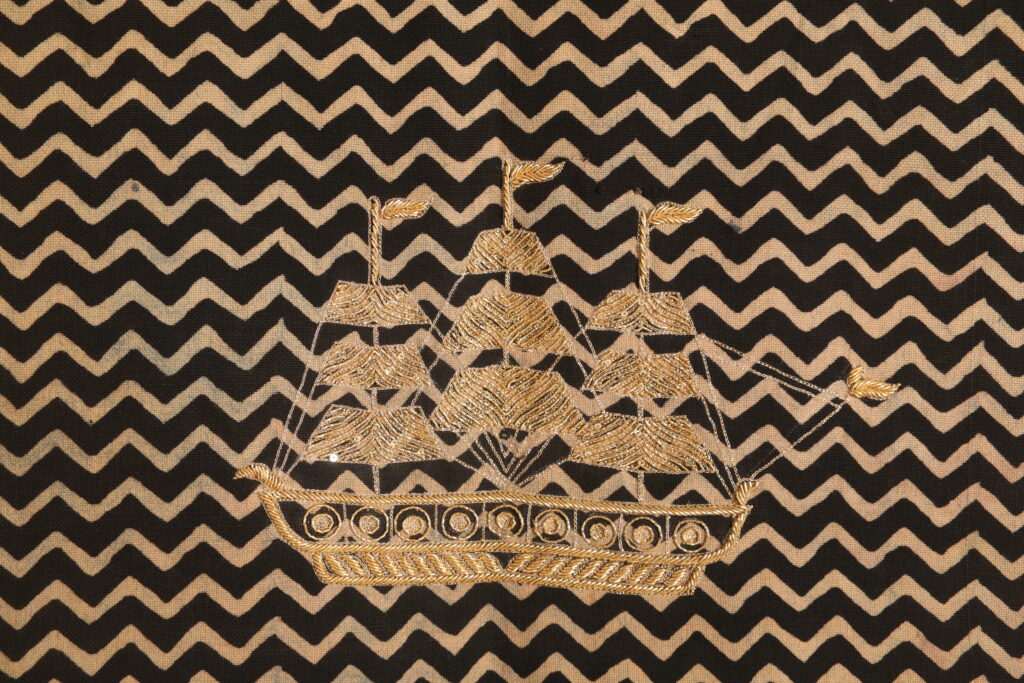
CENTERING THE MARGINS: TEXTILE ART OF SHELLY JYOTI
by JohnyML Indian art historian, curator, and writer
In summer, Gurugram, one of the richest suburbs in India’s capital city, Delhi, looks like a film set erected for the Star Wars franchise. The real estate boom remains unabated like the tropical summer heat. The curvaceous glassy exteriors of the buildings glimmer as they were the sweating backs of enslaved pirates pulling the oars of a ship. Suddenly from nowhere history falls into the vision with a thud. Slaves! In the 18thC–19thC, they were the engines of globalization; they have always been in the vicinity of development, invisible like phantoms. The word indigo recalls the history of US slavery, a different version of it from the East India Indigo Revolt, which had the seeds of a rebellion that changed the world.
Gurugram is the place where artist Shelly Jyoti lives. In the comfort of her spacious art studio, she shows the ajrakh works that she has been creating for the last few years which would be exhibited in the Indigo: The Blue Gold in Chicago. She takes out the works one by one that are neatly folded and kept, and her very act of displaying the works for critical perusal is performative; a performance which is mundane and accentuated alike. One cannot handle textile, even if it is done, shown, and purchased for everyday use, without some kind of performance involved in it. The stacks of the works, the ajrakh printed clothes with semiotically loaded images and symbols, become annals of a history book, which Jyoti has been trying to write and interpret all these years.
Between textile art, something that Jyoti keeps contesting in her self-positioning as an artist, and the history of the land, Jyoti needed a connection to be established so that aesthetics of its making wouldn’t fall into the gap. Ajrakh printing technique, which has been around since the Indus Valley Civilization, is reclaimed by Jyoti from its marginal state, a cottage based practice limited to a niche audience that faces gradual dwindling of patronage therefore visibility in the national discourse of aesthetical as well as functional art. Redeeming a marginalized art form from its complex causations and attributing it with an added historical and aesthetic value is a politico-economic intervention and Jyoti does it with diligence and elan.
Gandhi, the historical figure who emblematized world peace and India’s struggle for political independence had his political initiation in India after his prolonged stay in South Africa, through the strike of the indigo farmers in Champaran, the Northwestern part of Bihar, a north Indian state. Champaran became a point of departure for Jyoti in her early project titled “Indigo Narratives” (2009). History of slavery and the embedded aspirations for liberation through the figure of Gandhi and the number of faceless, nameless, and formless farmers found form and voice in Jyoti’s narratives. In the projects that followed Jyoti used ajrakh and indigo as mediums and methods, history and aesthetics objectified and made it a part of the conceptual discourse.
As her involvement with the histories of ajrakh, indigo, and Gandhian philosophy became deeper and more intense, Jyoti’s aesthetic dialogues started taking different trajectories where the performative act of making art got supplemented by poetry performances. A graduate in English literature before transforming herself into a full time artist who uses textiles as her major medium of expression, Jyoti supplements images and installations with words that function as extensions of the critical utterances. It is in the transitory spaces of visual expression and verbal utterance that Jyoti finds the need for “installing the ideas” that in terms of visual art could be called “installations” but for the artist they are ideas pushed into the space where the viewers could be surrounded by visuals, tactile forms, and verbal utterances. This is a sort of embracement of the object experience with the nuances of history through various forms of expressions.
Jyoti found her true resonance in Gandhian principles such as “Swaraj” and “Swadharma,” which could be roughly translated as “Self Rule” and “Sticking to Ethical Practice,” and sought ways to express the same using ajrakh and indigo as her mediums. Collaborating with the traditional practitioners of ajrakh dyeing, she developed an ensemble of images and emblems that kept weaving not only the said Gandhian principles but also the nuances of colonial history and the kinds of suffering that the subjects had to undergo. Jyoti as an artist does not forward an accusatory critique against the colonial past, instead she sticks to the idea of flagging out the issues that could be panned out to any juncture of history where the core ideas of colonial system could function without inflicting direct pain to the subjects.
Neo-colonialism is a vaporous one, spreading out everywhere causing exciting auditory and olfactory sensations, and leading the subjects to an enchanted trail to the cliff of destruction. The pied piper act of leading the innocent to unfathomable and inescapable chasms is what the neo-colonial forces do to human beings all over the world. Jyoti’s works open this fact from various angles and entry points but only those who have a sense of history could unspool such a complicated historical fact from equally enticing and intricate images that have historical validation of over four thousand years, unassumingly passed through times with elegance and dignity.
Images of ships play a pivotal role in the works of Jyoti because it reminds one of the early forays of human beings in establishing a global platform of commercial exchange. One cannot say for sure whether it was wanderlust that goaded men to set out for expeditions or their innate need to conquer other parts of the world. Whatever the case may be, they were all prodded by curiosity aroused by hunger and territorial aggression. Expeditions, first on foot, then on rafts and later in wind driven ships resulted to the idea of conquering and subjection, which eventually gave birth to the abominable practice called slavery and slave trade. A thing of curiosity enhanced by scientific and technological advancement slowly turned into human subjection, a historical irony. This irony is ironically emphasized by Jyoti through the image of a ship woven by golden threads. History must be written in golden threads!
The title of the show “the Blue Gold” has a ring of mythology. Gold, a metal that had once been discarded as a useless material for its lack of hardness and strength found its way into the commercial imagination of the states and people through its elevation as a mythological element that contained value of all the values. The metaphorical and symbolic values attributed to gold is such that it became the primordial divine egg from which the world emerged, Hiranyagarbha. Once drawn into the commercial parlance of value transactions, it became the fundamental bond and surety, and its natural sheen became more glistening and enticing. All the wars were fought not only for the territories but also for the reserve gold of the states. Gold became the stand in word for greed, avarice, and ruthlessness because it contained all the transactional values of the world.
There is no wonder why indigo was called “blue gold.” In a way it is connected to the first sin in the Biblical sense. When the forbidden fruit was tasted by the woman and man, they became aware of their nakedness. The story of clothing starts from that very incident of tasting a fruit. When the world economy was based on factory produced clothing, indigo became gold as it was the primary dyeing agent of the clothes. All the human beings on the face of the earth need clothes on their bodies. Clothing has remained the data of the world all the time because DATA is the new gold. With the arrival of new technologies and new dyeing agents, indigo might have lost its hold over the clothing industry. But like gold, indigo has gained a symbolic value, a value of struggle, forbearance, and independence. Can the introduction of ajrakh and indigo into the dominant practice of contemporary art redeem it from its marginal position? Can indigo as an idea bring back the historical nuances of human struggle and fight against slavery?
Shelly Joyti is not a sloganeer, but she has a vision and like a true champion of a cause that finds few supporters in the field, she is hopeful that one day ajrakh and indigo could exemplify history of art and politics. Blue Gold reaching the museum itself is not a small step.
JohnyML
Summer, New Delhi, 2023